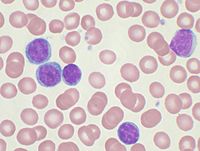
Photo from wikipedia
The three primary sites of acute T-cell mediated rejection (TCMR) in transplanted kidneys are the tubular epithelial cells, interstitum, and the vascular endothelial cells. The pathology of acute lesions is… Click to show full abstract
The three primary sites of acute T-cell mediated rejection (TCMR) in transplanted kidneys are the tubular epithelial cells, interstitum, and the vascular endothelial cells. The pathology of acute lesions is characterized by inflammatory cell infiltration; the final diagnosis suggested by the Banff 2019 classification is guided by grading of tubulitis (the t-score), interstitial inflammation (the i score), and endarteritis (the v score). Consistent major issues when using the Banff classification are the etiological classifications of interstitial fibrosis and tubular atrophy (IFTA). From 2015 to 2019, technological advances (i.e., genetic analysis in paraffin sections), increased our understanding of IFTA status in patients with smoldering acute TCMR and the roles played by inflammatory cell infiltration (the i-IFTA score) and tubulitis (the t-IFTA score) in IFTA. These two scores were introduced when establishing the diagnostic criteria for chronic active TCMR. Despite the increase in complexity and the lack of a consensus treatment for chronic active TCMR, the Banff classification may evolve as new techniques (i.e., genetic analysis in paraffin sections and deep learning of renal pathology), are introduced. The Banff conference proceeded as follows. First, lesions were defined. Next, working groups were established to better understand the lesions and to derive better classification methods. Finally, the new Banff classification was developed. This approach will continue to evolve; the Banff classification will become a very useful diagnostic standard. This paper overviews the history of TCMR diagnosis using the Banff classification, and the clinical importance, treatment, and prospects for acute and chronic active TCMR.
Journal Title: Nephron
Year Published: 2023
Link to full text (if available)
Share on Social Media: Sign Up to like & get
recommendations!